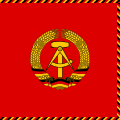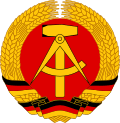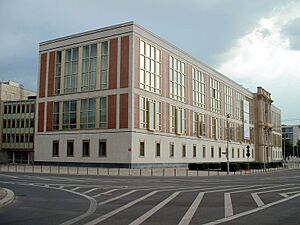State Council of East Germany facts for kids
Quick facts for kids State Council of the German Democratic Republic |
|
|---|---|

Flag of the Chairman of the State Council
|
|

Emblem
|
|
|
State Council Building, East Berlin
|
|
| Appointer | Volkskammer |
| Term length | 5 years |
| Constituting instrument | Constitution of East Germany |
| Precursor | President of the German Democratic Republic |
| Formation | 12 September 1960 |
| Abolished | 5 April 1990 |
The State Council of East Germany (in German: Staatsrat der DDR) was like a group head of state for East Germany from 1960 to 1990. Think of it as a team of leaders instead of just one person.
Contents
How the State Council Started
When East Germany was created in 1949, its first constitution made it look like a regular democratic country. It even had a President, Wilhelm Pieck. He was a leader of the main political party, the Socialist Unity Party of Germany (SED).
But the SED actually controlled everything in East Germany. When President Pieck died in 1960, the SED decided not to pick a new president. Instead, they created the State Council. This was a group of people who would act as the head of state together. This idea was similar to how the Soviet Union was run.
The State Council's role was set in the constitution. It stayed mostly the same in the 1968 constitution. However, its official power was later reduced in 1974.
Choosing the Members
The People's Chamber, which was East Germany's parliament, chose the members of the State Council. At first, they served for four years, but this was later changed to five years.
The State Council had a chairman, several deputy chairmen (usually six), other members (usually sixteen), and a secretary. These members came from different political parties and groups that worked with the SED. Sometimes, a well-known citizen was also included. Outside East Germany, the chairman of the State Council was seen as being like a president.
Even though the Chairman of the State Council was officially the second most important person in East Germany, the leader of the SED usually held this position. This meant the chairman was very powerful. There were only a few times when the SED leader was not the chairman, like during changes in leadership or right before East Germany ended.
What the State Council Did
The State Council had several important jobs:
- It called for elections for the People's Chamber and other government groups.
- It chose members for the National Defense Council, which handled defense.
- It could grant pardons, which means forgiving someone for a crime.
- It approved international agreements with other countries.
- It officially welcomed diplomats from other countries.
- It gave out awards and honors.
- It supported families with many children.
At first, the State Council could also create new laws and explain what the constitution meant. The chairman also had a special role in dealing with other countries. But in 1974, these special powers were officially removed.
Even though the Council was a group, its chairman had the most power, especially if he was also the leader of the SED. The State Council was important for advice and decisions when Walter Ulbricht was in charge. But when Ulbricht lost power, the Council became more of a ceremonial group. The changes in 1974 showed this. When Erich Honecker became chairman in 1976, his power came mostly from being the SED leader.
The State Council's office, with about 200 employees, also handled requests from citizens. Government and business groups had to work with this office on these requests.
The End of the State Council

When Egon Krenz, who took over from Honecker as SED leader, could not keep the Communist Party in power, he resigned from his jobs, including Chairman of the State Council. To show that the SED no longer had all the power, Manfred Gerlach, a leader from another party, was chosen as chairman. However, the State Council no longer had real political power. It just helped manage the change until the elections in March 1990.
The new People's Chamber, which was chosen in free elections, met for the first time on April 5, 1990. One of its first actions was to change the constitution and get rid of the State Council. As the constitution said, the president of the People's Chamber, Sabine Bergmann-Pohl, became the temporary head of state. She held this role until East and West Germany reunited on October 3, 1990.
Chairmen of the State Council
| Chairman | Political Party | Took Office | Left Office |
|---|---|---|---|
| Walter Ulbricht | SED | 12 September 1960 | 1 August 1973 |
| Willi Stoph | SED | 3 October 1973 | 29 October 1976 |
| Erich Honecker | SED | 29 October 1976 | 24 October 1989 |
| Egon Krenz | SED | 24 October 1989 | 6 December 1989 |
| Manfred Gerlach | LDPD | 6 December 1989 | 5 April 1990 |
See also
 In Spanish: Consejo de Estado de la República Democrática Alemana para niños
In Spanish: Consejo de Estado de la República Democrática Alemana para niños



